SUNY ESF
Students
Graduate Student and Alumni
For current Sloan Indigenous Graduate Fellows, visit the Sloan Indigenous Graduate Fellow page.
Annie Sorrell, Sowing Synergy Graduate Program
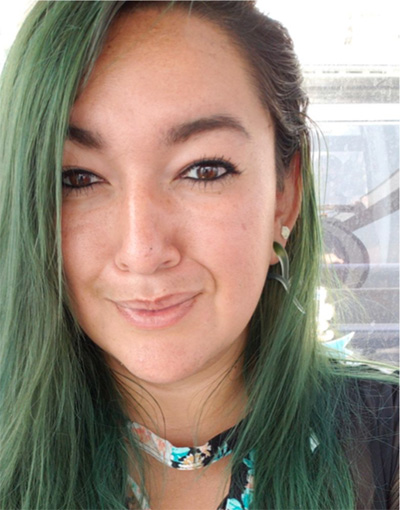 My name is Annie Sorrell I am a member of the Confederated Salish and Kootenai tribes.
I received my Bachelor's degree in Environmental Science at Haskell Indian Nations
University. I am currently pursuing my Master's degree in Conservation Biology at
SUNY ESF. Growing up on the Flathead Nation where my family resides, I have an interest
in understanding how reconnection to land and place can help heal intergenerational
traumas that are on reservations. My current research is designed to better understand
the traditional knowledge of Bitterroot Salish aromatic plants within the community
living on the Flathead Nation in Montana. Living in a world today where aromatic scents
can be purchased anywhere; I want to see if the traditional knowledge is being handed
down through the generations or with the modern world is the knowledge being lost.
I want to use the knowledge that I learn at SUNY ESF and bring it back to my communities.
My name is Annie Sorrell I am a member of the Confederated Salish and Kootenai tribes.
I received my Bachelor's degree in Environmental Science at Haskell Indian Nations
University. I am currently pursuing my Master's degree in Conservation Biology at
SUNY ESF. Growing up on the Flathead Nation where my family resides, I have an interest
in understanding how reconnection to land and place can help heal intergenerational
traumas that are on reservations. My current research is designed to better understand
the traditional knowledge of Bitterroot Salish aromatic plants within the community
living on the Flathead Nation in Montana. Living in a world today where aromatic scents
can be purchased anywhere; I want to see if the traditional knowledge is being handed
down through the generations or with the modern world is the knowledge being lost.
I want to use the knowledge that I learn at SUNY ESF and bring it back to my communities.
Kaya DeerInWater, Sowing Synergy Graduate Program
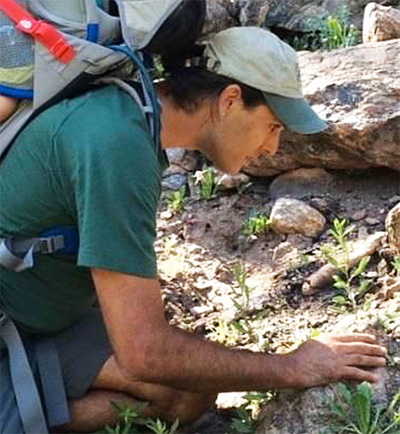
Kaya DeerInWater is from the Citizen Band of Potawatomi and lives in Wasétenak (Grand Rapids, Michigan) with his wife and three children. He is currently pursuing a Master’s degree in Biocultural Restoration at SUNY ESF in Syracuse, New York. His research focuses on the plant knowledge within the Citizen Potawatomi communities in Central Oklahoma. He received his undergraduate degree from University of California Davis in Ecological Restoration and Management. He previously worked as the Community Garden Manager for his band where he focused on growing both traditional and non-traditional crops and led workshops around building relationships with plants and the land through Indigenous foods and crafts. His vision is rebuilding robust Native food systems by building capacity through increased production, distribution, and consumption of nutritious, culturally significant, and sustainably harvested foods within Great Lakes Native communities.
Loga Fixico, Sowing Synergy Graduate Program
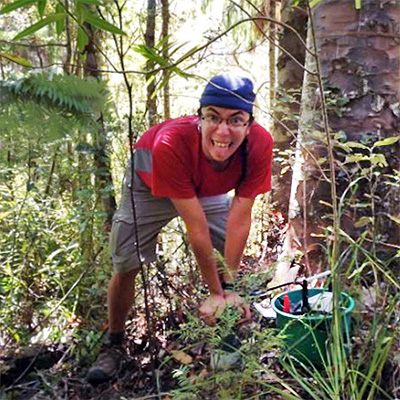 My name is Loga Fixico and I'm an Amskapi Pikunni (Blackfeet) man from the High Plains
of Montana. The Blackfeet Nation is a nation of warriors. And this is important to
understand because it's fundamental to our social values and the way we think. But
this warrior ethos has very little to do with fighting or killing, and everything
to do with maintaining our responsibilities. Growing up on an Indian reservation brought
challenges that I didn't expect when I was a boy. But they're challenges that I'm
grateful to have been given. I'm only the second person in my family to successfully
navigate college. Some of this success includes a Bachelor of Environmental Science
(Terrestrial Resources), an Associate of Forestry, a Master Level Tutor Certification,
and a Geospatial Science Certification. Although I now know it's far more important
to learn how to learn as opposed to learning what to learn, I'm extending my passions
into a Master's degree in biocultural restoration at SUNY ESF. I find it absolutely
fascinating how societies interface cultural values and ecological values, and how
these connections synthesize to create functional systems of management and restoration.
This is how I plan to contribute to the body of scientific knowledge and to my community's
long-term wellbeing.
My name is Loga Fixico and I'm an Amskapi Pikunni (Blackfeet) man from the High Plains
of Montana. The Blackfeet Nation is a nation of warriors. And this is important to
understand because it's fundamental to our social values and the way we think. But
this warrior ethos has very little to do with fighting or killing, and everything
to do with maintaining our responsibilities. Growing up on an Indian reservation brought
challenges that I didn't expect when I was a boy. But they're challenges that I'm
grateful to have been given. I'm only the second person in my family to successfully
navigate college. Some of this success includes a Bachelor of Environmental Science
(Terrestrial Resources), an Associate of Forestry, a Master Level Tutor Certification,
and a Geospatial Science Certification. Although I now know it's far more important
to learn how to learn as opposed to learning what to learn, I'm extending my passions
into a Master's degree in biocultural restoration at SUNY ESF. I find it absolutely
fascinating how societies interface cultural values and ecological values, and how
these connections synthesize to create functional systems of management and restoration.
This is how I plan to contribute to the body of scientific knowledge and to my community's
long-term wellbeing.
Raymond John Gutteriez, M.S., Ecology
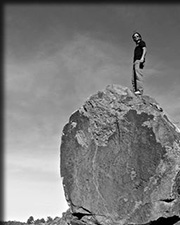
Hele nuum (Hello People), my name is Raymond John Gutteriez. I started my journey in graduate school in late August 2013. I have the good fortune to be a part of the Center for Native Peoples and the Environment, where I am pursuing a Master’s degree in Ecology. I remember when I was a little guy, following my grandmother and great-aunt around and learning about the different plants and animals of the Sierra Nevada. I watched and listened as names were spoken, uses explained and how we—human-animals—are to care for the plants, animals, air, water, land and one another. It was these early teachings which greatly influenced the way I see the world and directed my choice of college majors. I graduated from California State University at Fresno in 2010 with a degree in Ecology. I remember being frustrated in classes, where I attempted to share a different way of knowing the land, taught to me by my grandma and auntie, and having my ideas brushed aside for not being “scientific.”
In the short history of our species we have created, and continue to create, many wounds on our Mother Earth and on our own human-spirit. We oppress and exploit the land in the same way we oppress and exploit one another. We over look that the wounds we make on the land are the wounds we make on our spirits and the wounds we make on our spirits are the wounds we make on the land. We are intrinsically interconnected. But, far too often we attempt to separate the two. There is human civilization and there is the ‘nature’, the ‘wilderness’.
I work to encourage different ways of knowing the world. I want to be a part of the movement dismantling the wall dividing traditional ecological knowledge and scientific ecological knowledge. I want to empower communities to be stewards of their local environments, to rebuild the connection between people and the land. I know what it is like being the lone voice in a room talking about TEK, for that reason I work with indigenous youth to help them develop the vocabulary explain their world views and ways of knowing in a way western minds can understand.
I guess a little more of my history might be useful. I am a person of many cultures. I am Wuksachi-Mono, indigenous from the Sierra Nevada Range in California; I am black, African American, the descendent of escaped and freed slaves; I grew up in a Mexican community, East Salinas; I have watched my family navigate the economic spectrum and move from working-class to kind of middle class. I am constantly learning about history, my history, the history of struggle of poor people and people of color. I know the struggles those who have come before me have faced so that I can be where I am today. I see the legacy they have right our species, and thought we are far from being at a place respect and mutual appreciation for one another and all things I, and many like me are working to continue that legacy, to empower communities to shed the chains of imperialism and continue the transition to a more sustainable world ecologically and socially.
Sara Amanda Smith, M.S., Ecology
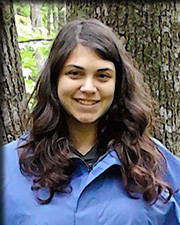
Sara Smith is a citizen of the Oneida Nation of Wisconsin and is the Midwest Tribal Resilience Liaison with the College of Menominee Nation - Sustainable Development Institute (CMN-SDI), in association with the Midwest Climate Adaptation Science Center (MW CASC).
As the liaison for the Midwest, she works on facilitating stronger relationships between Tribes, climate researchers, State and Federal organizations, academic institutions, and the MW CASC. In addition, she works with Tribes to build capacity and provides support by helping identify gaps and assisting with climate resilience efforts.
Sara holds a Master of Science in Ecology from the State University of New York – College of Environmental Science and Forestry and an undergraduate degree in Biology and First Nation Studies from the University of Wisconsin-Green Bay.
Undergraduate Students and Alumni
Cassandra Beaulieu, Indigenous Environmental Leaders for the Future Fellowship Recipient
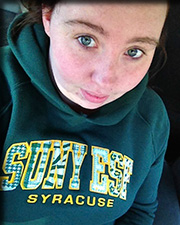 Shé:kon, my name is Cassandra Beaulieu (Mohawk Nation) and I am currently pursuing
a B.S. in Environmental Chemistry here at SUNY ESF with a focus on aquatic chemistry.
I earned an A.S in Mathematics & Science with a concentration in chemistry at Cayuga
Community College. This past summer I participated in the Summer Undergraduate Research
Fellowship in Oceanography (SURFO) at the Graduate School of Oceanography, University
of Rhode Island. During this time I developed a method for accurately measuring the
nitrogen isotopic composition of ammonium in water samples provided by wastewater
treatment facilities that discharge into the Narragansett Bay watershed. Making these
particular nutrient measurements can give insight to what sources of nitrogen are
controlling the watershed nutrient loads and can help in mediating eutrophication
and hypoxia in the bay. I am also working on a senior project in the chemistry department
at ESF dealing with the effects of CDOM (colored dissolved organic matter) on carbon
dioxide gas transfer in freshwater systems. Due, in part, to these experiences, I
am interested in nutrient cycling in aquatic systems and plan on pursuing a PhD in
Chemical Oceanography in the near future. In regard to my involvement as an indigenous
environmental leader for the future, I am enjoying connecting TEK to my interests
in aquatic chemistry and learning how an indigenous cultural background can be at
the forefront of my education in a STEM field.
Shé:kon, my name is Cassandra Beaulieu (Mohawk Nation) and I am currently pursuing
a B.S. in Environmental Chemistry here at SUNY ESF with a focus on aquatic chemistry.
I earned an A.S in Mathematics & Science with a concentration in chemistry at Cayuga
Community College. This past summer I participated in the Summer Undergraduate Research
Fellowship in Oceanography (SURFO) at the Graduate School of Oceanography, University
of Rhode Island. During this time I developed a method for accurately measuring the
nitrogen isotopic composition of ammonium in water samples provided by wastewater
treatment facilities that discharge into the Narragansett Bay watershed. Making these
particular nutrient measurements can give insight to what sources of nitrogen are
controlling the watershed nutrient loads and can help in mediating eutrophication
and hypoxia in the bay. I am also working on a senior project in the chemistry department
at ESF dealing with the effects of CDOM (colored dissolved organic matter) on carbon
dioxide gas transfer in freshwater systems. Due, in part, to these experiences, I
am interested in nutrient cycling in aquatic systems and plan on pursuing a PhD in
Chemical Oceanography in the near future. In regard to my involvement as an indigenous
environmental leader for the future, I am enjoying connecting TEK to my interests
in aquatic chemistry and learning how an indigenous cultural background can be at
the forefront of my education in a STEM field.
Kathryn Goodwin, Indigenous Environmental Leaders for the Future Fellowship Recipient
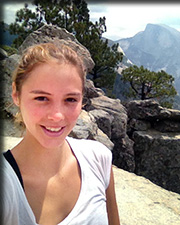 Oki, my name is Kathryn Goodwin. I will be a junior in Environmental Studies with
a focus in policy, planning, and law. I am from Los Angeles, where I went to community
college before transferring here this past fall. I am of Blackfeet heritage and being
a part of the Indigenous Environmental Leaders of the Future has allowed me to gain
a closer connection to my ancestry and to others' heritages. I am interested in food
security and the ways in which climate change is affecting agriculture across the
world. More recently, I have become interested in learning all I can about the drought
in California. As a life long resident of the state, it's water crisis is very personal
to me. Seeing the news media cover it, makes me realize that what happens in California
will undoubtedly affect the whole state, no matter what coast you live on. In the
future, I would like to go into water policy/security and look at the ways in which
water wars will be the wars of the future.
Oki, my name is Kathryn Goodwin. I will be a junior in Environmental Studies with
a focus in policy, planning, and law. I am from Los Angeles, where I went to community
college before transferring here this past fall. I am of Blackfeet heritage and being
a part of the Indigenous Environmental Leaders of the Future has allowed me to gain
a closer connection to my ancestry and to others' heritages. I am interested in food
security and the ways in which climate change is affecting agriculture across the
world. More recently, I have become interested in learning all I can about the drought
in California. As a life long resident of the state, it's water crisis is very personal
to me. Seeing the news media cover it, makes me realize that what happens in California
will undoubtedly affect the whole state, no matter what coast you live on. In the
future, I would like to go into water policy/security and look at the ways in which
water wars will be the wars of the future.
Kimberly Hill, Indigenous Environmental Leaders for the Future Fellowship Recipient
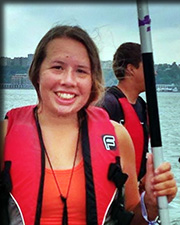 Čwe'n, kyà:0e Yehehnakwáhstha?. Hi, my name is Kim Hill and I'm from the Tuscarora
Nation (near Niagara Falls, NY). I graduated from Bard College at Simon's Rock with
an Associate's degree in liberal studies. I transferred to SUNY ESF in 2013 to focus
more on environmental studies and was accepted as a fellow for Indigenous Environmental
Leaders for the Future. I'm currently pursuing a Bachelor's degree in Natural Resources
Management with minors in Water Resources and Recreation Resource & Protected Area
Management. Last year, I was accepted as part of the Doris Duke Conservation Scholars
Program at Northern Arizona University. I've spent the past summer working with conservation
issues on the Colorado Plateau and the Grand Canyon region where we did service-learning
projects and various field trips. I also worked with USGS on Sagebrush Habitat Assessment
in Utah, Colorado and Wyoming. This summer I will be working with USGS again as part
of the DDCSP. The internship is studying the impact of nonnative predators on native
Hawaiian pollinators and plants while also looking at (eradication) management techniques
for pollinator restoration.
Čwe'n, kyà:0e Yehehnakwáhstha?. Hi, my name is Kim Hill and I'm from the Tuscarora
Nation (near Niagara Falls, NY). I graduated from Bard College at Simon's Rock with
an Associate's degree in liberal studies. I transferred to SUNY ESF in 2013 to focus
more on environmental studies and was accepted as a fellow for Indigenous Environmental
Leaders for the Future. I'm currently pursuing a Bachelor's degree in Natural Resources
Management with minors in Water Resources and Recreation Resource & Protected Area
Management. Last year, I was accepted as part of the Doris Duke Conservation Scholars
Program at Northern Arizona University. I've spent the past summer working with conservation
issues on the Colorado Plateau and the Grand Canyon region where we did service-learning
projects and various field trips. I also worked with USGS on Sagebrush Habitat Assessment
in Utah, Colorado and Wyoming. This summer I will be working with USGS again as part
of the DDCSP. The internship is studying the impact of nonnative predators on native
Hawaiian pollinators and plants while also looking at (eradication) management techniques
for pollinator restoration.
Meleimoana Ta’alolo Su’esu’e, Indigenous Environmental Leaders for the Future Fellowship Recipient
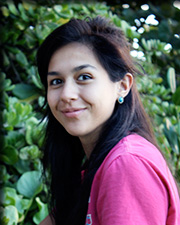 Talofa, my name is Mele, I'm a sophomore majoring in Environmental Resources Engineering.
I am of Samoan heritage and I was born and raised in Hawai'i. I have always been interested
in environmental science, which is why I first applied to ESF. Being a part of the
Indigenous Environmental Leaders of the Future allows me to learn about the importance
of Traditional Ecological Knowledge. I am interested in ecological restoration and
sustainable development. In the future, I hope to use TEK combined with western science
to promote cultural and ecological sustainability in island communities.
Talofa, my name is Mele, I'm a sophomore majoring in Environmental Resources Engineering.
I am of Samoan heritage and I was born and raised in Hawai'i. I have always been interested
in environmental science, which is why I first applied to ESF. Being a part of the
Indigenous Environmental Leaders of the Future allows me to learn about the importance
of Traditional Ecological Knowledge. I am interested in ecological restoration and
sustainable development. In the future, I hope to use TEK combined with western science
to promote cultural and ecological sustainability in island communities.
